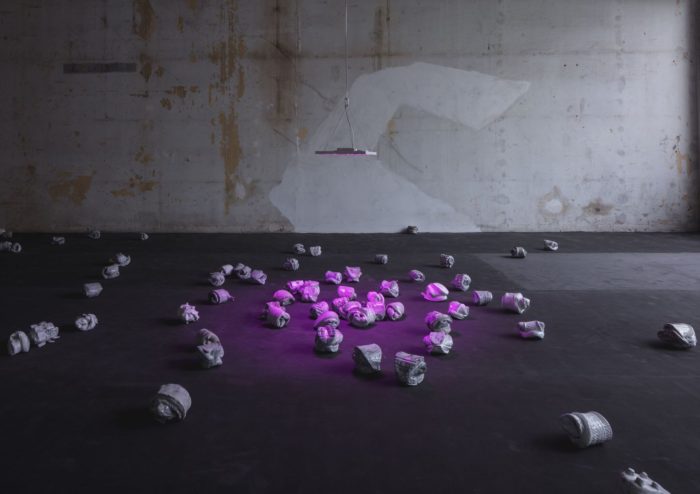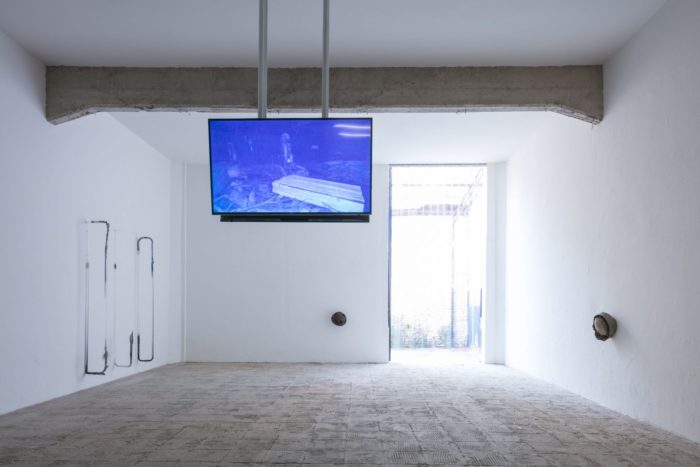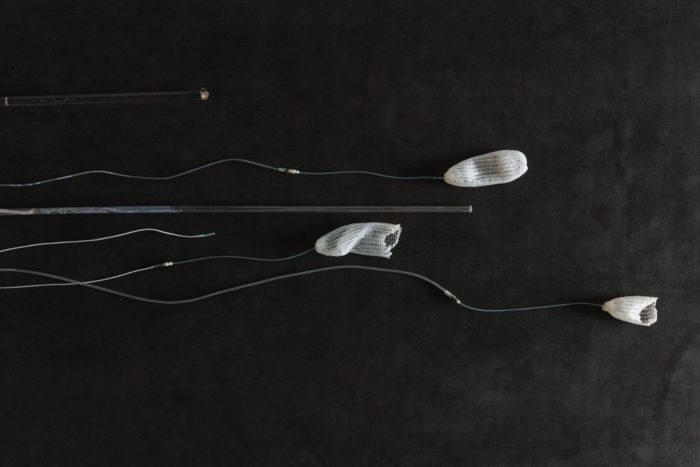Reading time: 6 minutes

10.01.2018
Galeria Jaqueline Martins, São Paulo, Brazil
November 11, 2017 – January 20, 2018



We live in a paradoxical time where instability has become a permanent state. Technological developments, especially the so-called digital revolution, have completely changed how we relate to the world, progressively contaminating all areas of our life. Distinctions between fields such as work and leisure or economy and ecology have grown impractical. This breaking down of boundaries and definitions underscores the interpenetration of domains formerly viewed as distinct. Our cultural environment has become our natural habitat, prompting us to recognize the composite character of our constitution as human beings. Responding to this uncertain context, lines of thought such as object-oriented ontology or the set of discourses collectively dubbed as Anthropocene (and the variations thereof), explore the presence of non-human entities, recontextualizing humanity within the realm of an expanded network of agencies. The current moment is one where these types of tensions make themselves felt in an ever-faster way, translating into a widespread idea of crisis primarily associated with the economic realm, but also clearly sensed in its ecologic, philosophical, humanitarian and political aspects.
Reflecting those displacements, Adriano Amaral’s practice investigates the processual characteristics of a rhizome-like context made from cross-contaminating contrasts. The show relies on the gallery space as a unifying thread, building its narrative across both gallery floors. The ground floor is taken up by the eponymous Rurais video. Shown at once in two flat-screen TVs hanging from the same structure, but facing opposite sides of the room, the video features night shots of the artist’s grandparents’ farm. Filmed with a drone, the footage of storage sheds, empty spaces and abandoned farming utensils conjures a post-apocalyptical scenario reminiscent of the pictures taken by robots during the Fukushima nuclear disaster. Known as ASMR (Autonomous Sensory Meridian Response), the accompanying audio is designed to elicit physical sensations in the listener’s body, not unlike a sound-tact kinesthesia phenomenon. This phantasmal dimension that Rurais conveys is further compounded by the pieces attached to the walls that surround the TV sets: a number of wasp nests and an ambiguous set of sculptures. Each of the insect structures gives off different artificially-designed noises that add to the sound that accompanies the footage. Altogether, they provide ambience, adding to the tension and quirkiness of these organic bodies.
The other set of sculptures, composed of thin, long, tubular elements, is a circuit that reflects the modular arrangement of the wasp nests, recreating a hybrid agency between the organic and the artificial, besides existing as a remnant of a system past or an element of an infrastructure-to-be. On the upper floor, the cement floor is covered with a black rubber coating that is soft to walk on, thereby underscoring our physical constitution. The room is populated by some 50 elements whose bright surfaces contrast with the matte flooring. Under an ultraviolet light, the oblique shapes reveal themselves to be pieces of footwear that were manipulated in different ways, some of them folded and burnt, and then coated in layers of silicone and spirulina, a type of seaweed. Just like in the ground floor circuit, the ambiguous character of these shoe-sculptures straddles the line between relics from a time past, residue from a disaster that completely altered their appearance and consistency, and notes from a time yet to come, conserved like carapaces or shells, a way for new, developing beings to protect themselves through contraction and expansion. Highlighting this type of conceptual superimposition that underlies the exhibition, three other sculptures built from obsolete pieces of agricultural machinery and attached to huge tanks emit a constant cloud of water vapor that hovers above them. Pipes jutting out from the sculptures sprawl across the floor.
The concrete, ethereal action of the set of sprinklers echoes the information cloud that encircles us, indicating their ubiquity and their existence as a biotype under permanent reconfiguration, both of which are central characteristics of the artificial intelligence systems that regulate our day-to-day. The combination of elements on this floor conjures the image of a dysfunctional factory, suggesting superimposing references that include an industrial assembly line or a greenhouse. The necessary presence of humans to activate the shoe-sculptures and farming machines underscores their present absence. Thus, these two sculpture sets prove to be indices of the ongoing transition from a working typology reliant on motor-mechanical force into a modality that centers on the immateriality of intellectual activity which defines the digital age. The rubber-coated floor returns like an apparition, reminding us of our corporeal condition that is constantly dulled up by the operational and representational regime hailing from Silicon Valley. More than expanding the absence of human beings, this discordant relationship between the corporeal and the immaterial the exhibition choreographs incorporates visitors into its physical and symbolical field, wiping away the distinction between what’s represented and what’s experienced.
Rurais presents a frailty which emphasizes the divergent, evolving forms that mark the contemporary condition. Numerous signs point to Amaral’s interest in a present of latency and discordance, weaving a web of associations that inhabit different objects, reemerging at different points in time: the video features camera movements at once machine-like and fluid; the wasp nests build friction between presence and absence; the sound confronts the corporeal and the immaterial; the tubular sculptures present themselves as biotechnological fragments from a time unknown; the shoe-sculptures combine organic and industrial materials; the material on the floor references notions such as opacity and transparency; and the water sprinklers indicate a state of transition, somewhere between solid, liquid and gaseous. For the most part, the objects are easily recognized, even if they’re not part of our daily lives. This gesture relates to Amaral’s interest in the material relationships that these elements sustain with the world at large. In the context of his work, the (art) object becomes a component of a macrostructure whose numerous social dynamics are amenable to analysis. Both exhibition floors convey a dystopic, mystical scenario replete with ghosts, relics and traces of human activity that hint at a later stage in which a new order will emerge, free from the actions of human beings. Among other examples with distinct features, the robot-like movements of the sprinklers and the sounds from the wasps’ nests are concrete, heterogeneous gestures of non-human agencies in full activity.
Overall, the show produces a disquieting setting which articulates the whirlwind that defines the current historical moment. In pondering the intangible character of contemporary living conditions, the seeming abstraction of the work comes through as an investigation that pays attention to what’s real. Its intrinsic relationship with the exhibition space, making it almost a site-specific gesture, is an indication of that interest, translated into a widespread exploration of forms, materials, symbols and temporalities within the specificity of here and now. Likewise, the tentative temporality that the pieces inhabit and convey resembles the coexistence of different timeframes in the present, and as such it informs yet another mechanism which situates the artist’s practice in the realm of social analysis. The post-human character of the narrative featured in Rurais does not constitute a form of departure from society, but rather the formulation of a new understanding of our environment as a network-based platform where we’re one of many existing elements, interacting with several other agencies. From this perspective, the work of Adriano Amaral can be interpreted as a form of sociological alchemy, shedding light on the anxieties of the present and questioning its concrete conditions in order to articulate and materialize abstract social systems.
João Laia
http://galeriajaquelinemartins.com.br
Comments
There are no coments available.